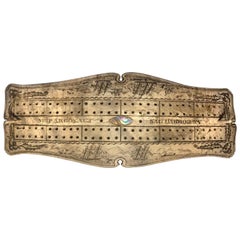Scrimshaw Cribbage
Antique Early 19th Century American Folk Art Antiquities
Tortoise Shell
Recent Sales
Early 20th Century Folk Art Games
Bone
Antique Late 19th Century American Folk Art Nautical Objects
Bone
Antique Late 19th Century American Folk Art Game Boards
Bone
People Also Browsed
Antique Mid-19th Century English High Victorian Taxidermy
Other
Antique 1820s British George IV Games
Wood
Antique Mid-19th Century Nautical Objects
Teeth
2010s American Art Deco Decorative Boxes
Brass, Steel
Antique Early 19th Century American Primitive Furniture
Hardwood
20th Century Victorian Historical Memorabilia
Resin
Antique 1820s British George IV Games
Wood
Antique 18th Century European Sculptures and Carvings
Natural Fiber
Antique 1880s British Late Victorian Decorative Boxes
Malachite, Brass
21st Century and Contemporary Books
Paper
Antique Mid-19th Century American Maps
Linen, Paper
Antique 19th Century English Late Victorian Historical Memorabilia
Bronze
Mid-20th Century American Mid-Century Modern Toys and Dolls
Wood
2010s Italian Medieval Games
Marble, Sterling Silver
Antique 19th Century English Georgian Figurative Sculptures
Wood
Early 20th Century English Edwardian Games
Oak
A Close Look at Folk-art Furniture
Folk art is a genre of art that shares the creator’s traditions, offering not just an artistic display but an opportunity to learn about a culture. Antique, new and vintage folk art typically reflects a heritage or location. It can include utilitarian objects and handmade art as diverse as weather vanes, duck decoys, portraiture and paintings, carnival art and quilts.
Quilts are a quintessential part of American folk art but their roots are international, with quilting dating back to Ancient Egypt. The practice spread to Europe and was especially prominent in the Middle Ages, with one of the oldest surviving examples being the Tristan quilt made in Sicily in the 14th century. They were made as bedcovers and clothing, including as a layer for knights to wear beneath their armor. Native American folk art includes functional objects reflecting their heritage, such as baskets, textiles and wooden pieces.
Elsewhere, the vast range of work associated with Mexican folk art includes masks made by Mexican craftspeople for traditional celebrations and ceremonial dances. Mexican masks are part of the country’s folk-art traditions that go back thousands of years and play a role in festivals and theater.
Works in the folk art tradition are valuable because of the skills involved, like weaving, hand-carving wood and even stonework. Many folk artists are self-taught, while some train as apprentices within their community. By using available materials and taking a personal approach to their creations, artists ensure each piece is unique and conveys a story.
During the Great Depression, artistic materials in America were hard to come by, so artisans used discarded wood from cigar boxes and shipping crates to make highly stylized, notched pieces — most often picture frames and boxes — that are today sought after by collectors. This folk art style is called tramp art and was popular from roughly 1870 until the 1940s.
Folk art brings vibrant culture and traditions into your home. Browse an extensive collection of antique, new and vintage folk art on 1stDibs.
Read More
An Inspiring Collage by Self-Taught Miami Artist Purvis Young
In 1995, the artist embellished a found poster of Martin Luther King with visionary markings.
At Colonial Williamsburg, Everything Old Is New Again
With the help of a new director, the Virginia institution's folk art and decorative arts museums are undergoing extensive upgrades.
Daniel Rozensztroch Can’t Live with Enough Beautifully Useful Objects
The French designer, stylist and creative director offers an inside look at the cabinets of curiosities he calls home in Paris and Nice.
Tramp Art, America’s Most Misunderstood Art Form, Is Trending in Interiors
Designers are beginning to see this enigmatic form of folk art in a whole new light.


